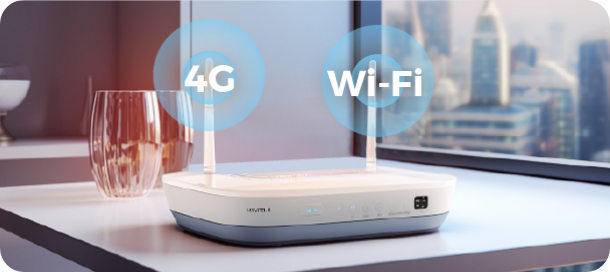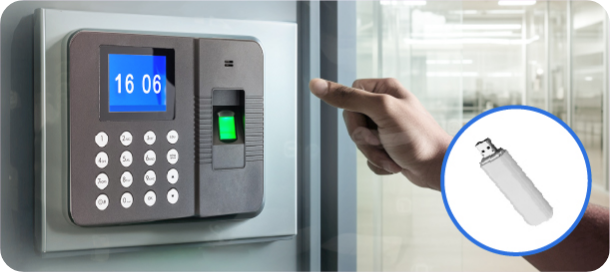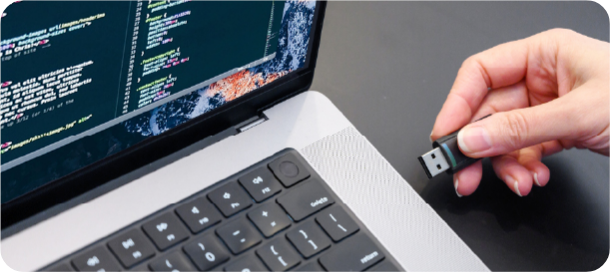- Home
- Hardware
- SDKs
- Cloud
- Solutions
- Support
- Ecosystem
- Company
- Contact
USB (Universal Serial Bus) is a standard set of connectivity specifications enabling communication between various external devices and a host controller. Espressif’s USB Solutions provide users with a convenient and efficient way for device interconnection and data transmission. The ESP32-S, ESP32-C, and ESP32-P series of SoCs incorporate USB as one of their standard peripheral devices, providing USB 2.0 OTG (On-The-Go) and/or USB-Serial-JTAG interfaces for both Host and Device modes. This offers users a variety of USB Host solutions, such as doorbell cameras, 4G IoT gateways, electronic photo albums, and attendance machines, as well as USB Device solutions, namely peripherals, such as a keyboard, mouse, USB flash drive, microphone, etc.

USB 2.0 OTG
USB Host Solution
USB Device Solution
Configuring devices equipped with Espressif SoCs in Host mode enables them to connect to, control, and manage a variety of USB peripherals. With the USB Host Solution, users can effortlessly achieve tasks such as audio/video transmission, 4G Wi-Fi connectivity, large-capacity storage, and human-machine interaction.

USB Multimedia

USB 4G Wi-Fi Router

USB External Storage

USB Human Interface

The USB Audio/Video Transmission Solution supports standard UVC (USB Video Class) and UAC (USB Audio Class) drivers. It utilizes a native USB interface that seamlessly connects to cameras, enabling the simultaneous implementation of USB camera data streaming, JPEG decoding, a real-time LCD, and Wi-Fi image transmission via a single SoC. This solution is suitable for creating applications such as cat-eye cameras, smart doorbells, smart locks, electronic endoscopes, and more.
- Easy Connection
- Synchronous Transfer (MJPEG 480x320 @15FPS)
- Bulk Transfer (MJPEG 800x480 @15FPS)
- Simultaneous Audio-Video Transmission and Management
- High-definition 800x480 RGB Display
The USB 4G Wi-Fi Router Solution supports standard USB CDC (Communications Device Class) drivers. It connects to 4G Cat.1 and Cat.4 modules through the native USB interface, enabling "medium to high-speed" dial-up internet access. Simultaneously, it can activate Wi-Fi Soft-AP mode, allowing the sharing of hotspots with IoT devices or human-machine-interaction devices to achieve cost-effective, medium- to high-speed networking. This solution is suitable for building applications such as 4G IoT gateways, MiFi (mobile) hotspots, smartwatches, outdoor cameras, advertising lightboxes, and more.
- Download speed of up to 6.4 Mbps and upload speed of up to 5 Mbps in typical working environments
- Compatible with mainstream 4G modules
- USB hot-swapping
- 4G module status management
- Router backend management
The USB external storage Solution enables Espressif SoCs to achieve functions such as USB flash drive mounting, file system access, and OTA upgrades. This solution is compatible with USB 3.1/3.0/2.0 protocols and supports Fat32-formatted USB drives, suitable for building applications like electronic photo albums, attendance machines, recording instruments, and other scenarios that require external storage.
- Maximum 32 GB storage space
- File systems access
- Fat32/exFat formats
- OTA via USB drive
The USB Human Interface Solution supports Host HID (Human Interface Device) drivers, allowing users to transmit real-time control signals of human-computer interaction devices through the USB interface. This expands communication and interaction between users and computer systems, as well as other digital devices. The solution is suitable for building applications such as HID wireless adapters, minicomputer systems, mini video game players, and other human-computer interaction scenarios.
- Wide compatibility with HID-like devices
- Standard USB input peripherals
- Gaming peripherals
Configuring devices equipped with an Espressif SoC in Device mode, and leveraging Espressif's proprietary USB protocol stack or the open-source TinyUSB protocol stack, enables the devices to function as USB devices. This allows them to connect and interact with computers or other host devices through the USB interface. With the USB Device Solution, users can easily build USB devices for storage, HID (Human Interface Device), as well as audio and video applications.

USB Wireless Disk

USB HID Device

USB Audio

USB Video

The USB Wireless Flash Drive Solution is built on the USB Mass Storage Class (USB MSC) device standard. Integrating Wi-Fi capability into the device enables the development of shared wireless large-capacity storage devices, such as USB storage, card readers, digital music players, digital media players, and more.
- USB-Wi-Fi bidirectional access
- Multiple device connections
- File synchronization
The USB Human Interface Device (HID) Solution allows Espressif SoCs to emulate various human-machine interface devices, such as keyboards, mice, game controllers, etc. The host system can interact seamlessly with these devices without requiring special drivers.
- USB + BLE HID Dual Mode
- Abundant open-source resources for easy development
- Custom HID Descriptors
The USB Audio (USB Audio Class) Solution enables Espressif SoC to function as an audio device, providing convenient and high-quality audio transmission capabilities. It can be utilized as a microphone or speaker that connects to USB audio-supported devices, such as computers, to facilitate audio input and output.
- UAC 2.0
- Multiple data formats
The USB Video (USB Video Class) Solution enables Espressif SoC to function as a USB Camera device, providing excellent camera capabilities for various applications. This includes building USB doorbell cameras or USB + Wi-Fi dual-mode network cameras.
- USB UVC (USB Video Class) device driver
- Maximum 720P @15FPS MJPEG (Motion JPEG)
USB-Serial-JTAG
Specialized USB Device Solution
The USB-Serial-JTAG interface comprises USB-to-Serial and USB-to-JTAG converters. The chip can be directly connected to a PC host via the USB-Serial-JTAG interface, enabling factory-built specialized USB device functions, such as firmware flashing, log output, and JTAG debugging. The specialized USB Device Solution eliminates the need for external bridging, utilizes fewer pins, accelerates firmware download speeds, and simplifies the JTAG debugging configuration.
USB Flashing
USB flashing is one of the primary functions of the specialized USB Device Solution. Traditional devices typically use a serial port for flashing, requiring an additional serial-to-USB chip for connecting to a computer. In contrast, devices equipped with an Espressif SoC can directly connect to a computer by using the USB flashing feature. The USB flashing function inherently supports two firmware download modes: USB CDC (requires support for USB-Serial-JTAG peripherals) and USB DFU (requires support for USB-OTG peripherals), providing increased flexibility and efficiency. Its flashing speed also surpasses that of serial port flashing by several times.

Contact Us
If you have any questions about the USB Solutions or are seeking a business collaboration with Espressif, please contact our customer support team.



